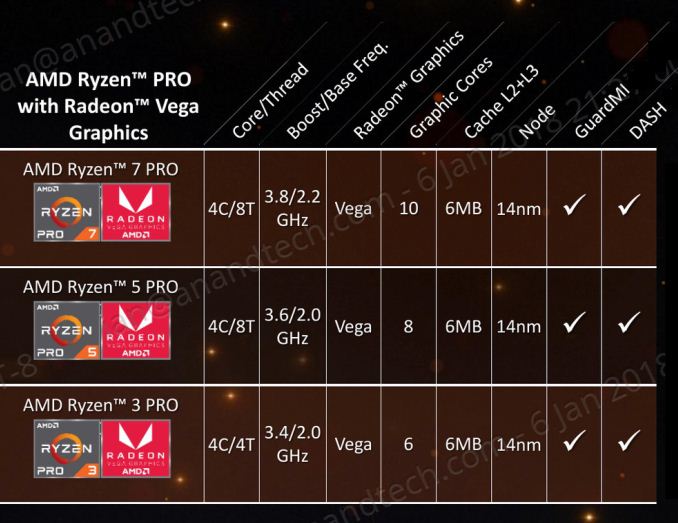AMD Tech Day at CES: 2018 Roadmap Revealed, with Ryzen APUs, Zen+ on 12nm, Vega on 7nm
by Ian Cutress on February 1, 2018 8:45 AM ESTZen and Vega: Ryzen PRO Mobile
In the second half of last year, AMD’s Enterprise, Embedded and Semi-Custom division (now the Enterprise and Embedded division) launched its Ryzen PRO family of desktop processors, for business customers that needed additional management capabilities. AMD has been making ‘Pro’ versions of its consumer processors for several generations now, usually mimicking the specifications of the consumer products aside from the management support.
These products, by and large, go up against Intel’s equivalent vPro processors, and AMD’s value add revolves around support for DASH, an open-source management protocol, TSME (transparent secure memory encryption), and its commitment to customer requests such as operating system image stability (18-months), guaranteed processor availability (24-months), manufacturing specifications designed for long-term reliability, and a commercial limited warranty (36-months). AMD also likes to tout that it offers a Pro product at the lower end of the market, where Intel does not have a vPro-enabled Core i3.
As part of the AMD Tech Day, it was announced that the Ryzen PRO Mobile family will be launched in Spring 2018. These components are, by and large, the Ryzen Mobile family of processors with Vega graphics but with the added Pro features listed above. For performance and power, AMD states similar sorts of numbers as it did with the launch of Ryzen Mobile: up to 270% better performance per watt, targeting 13 hours of useful battery life, 9 hours of HD video playback, and targeting a generation of sleek and powerful laptops, in this case focused for the Enterprise market.
So much like the Ryzen 7 2700U, the Ryzen 5 2500U, and the Ryzen 3 2300U, AMD will launch the Ryzen PRO Mobile equivalents:
We are likely to see OEMs that currently provide AMD A-Series PRO notebooks to offer updated versions with these new processors, as well as a series of new designs coming into the business and enterprise market.











131 Comments
View All Comments
haukionkannel - Monday, January 8, 2018 - link
Vega 7nm is for mobile first, so that is the priority in gpu. Only the desktop version in 2019.jjj - Monday, January 8, 2018 - link
Nor quite. Vega on 7nm is a SKU aimed at machine learning that samples in late 2018. That means volume in 2019 and other SKUs later , if there are other SKUs- I am unclear if AMD stated that there are other SKUs or that's an AT assumption.There is a possibility that Navi hits high end in 2019 and Vega lives bellow but that's kinda silly as AMD needs to be in a huge rush to replace Vega with something that is more competitive.
haukionkannel - Monday, January 8, 2018 - link
True. The machine learning chips Are the top priority I was just quessing that mobile part would Also get upgrade. My bad...So next Vega goes against machine learning Volta. Maybe Nvidia neither will release normal Volta, only those calculate monsters to AI projects. That would be interesting.
jjj - Wednesday, January 10, 2018 - link
Vega 7nm is 2019 for volumes it seem, Volta V100 will be replaced by something new likely this year and again in 2019- at the very least there will be one update.What Nvidia will do in consumer is unclear as there is no pressure on them to spend on releasing new things. The Intel+AMD part is problematic in laptop so likely they'll address that segment soon with something new.
Pinn - Monday, January 8, 2018 - link
Lisa is my waifu. I'm fine with my wife and daughter reading this.StevoLincolnite - Monday, January 8, 2018 - link
Ugh. No Navi until 2019. So AMD's graphics are guaranteed to be terrible for another year.Pinn - Monday, January 8, 2018 - link
and nvidia is guaranteed not to release volta for consumers.. fun.Xajel - Monday, January 8, 2018 - link
I was really hoping for a low power 8C/16T Ryzen CPU's, these can be used in SFF & laptops with dGPU already... these will be for those who want more CPU performance than GPU, or they need both CPU & GPU power.A5 - Monday, January 8, 2018 - link
You'll probably have to wait for 7nm for that. Current thermal budgets in laptop designs just aren't going to get you usable 16T performance from 35-45W.neblogai - Monday, January 8, 2018 - link
Table of Ryzen Mobile CPUs has all Raven Ridge APUs with '1MB per core'. But this is not true for R3 2200U, which still has the same 4MB of L3: http://www.amd.com/en-us/press-releases/Pages/ces-...Also- I still hope that is a Banded Kestrel die. On that topic, Joe Macri, when asked about RR use for fanless designs back in October, said it would not work too well, and would have to be clocked real low; when asked if they are building a different chip for that fanless market- answered only broadly- 'we love PCs,.. we want you to find AMD everywhere where PC is'. So I'm not sure- does that still mean only Stoney Ridge (if it qualifies for fanless), or a new die. Just looking at the AMD's below average power efficiency in RR laptops at browsing and playing video- maybe AMD knew they are simply not ready for fanless, and need to put in more work. But I still wish they released Zen 2C/4T 3CU - if not low power- then at least for even cheaper normal laptops. After all- Raven Ridge is not very small die at 210mm2, and a very cheap ~110mm2 die with 2c/4t Zen could also be successful.